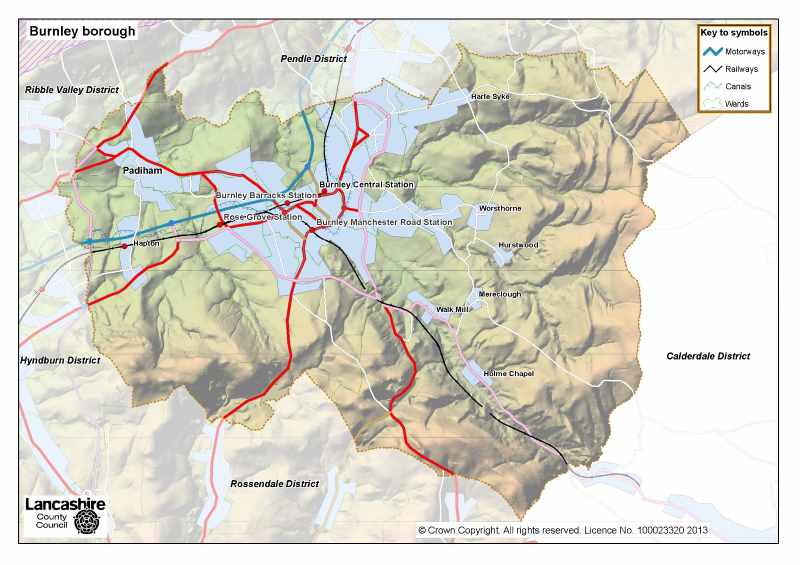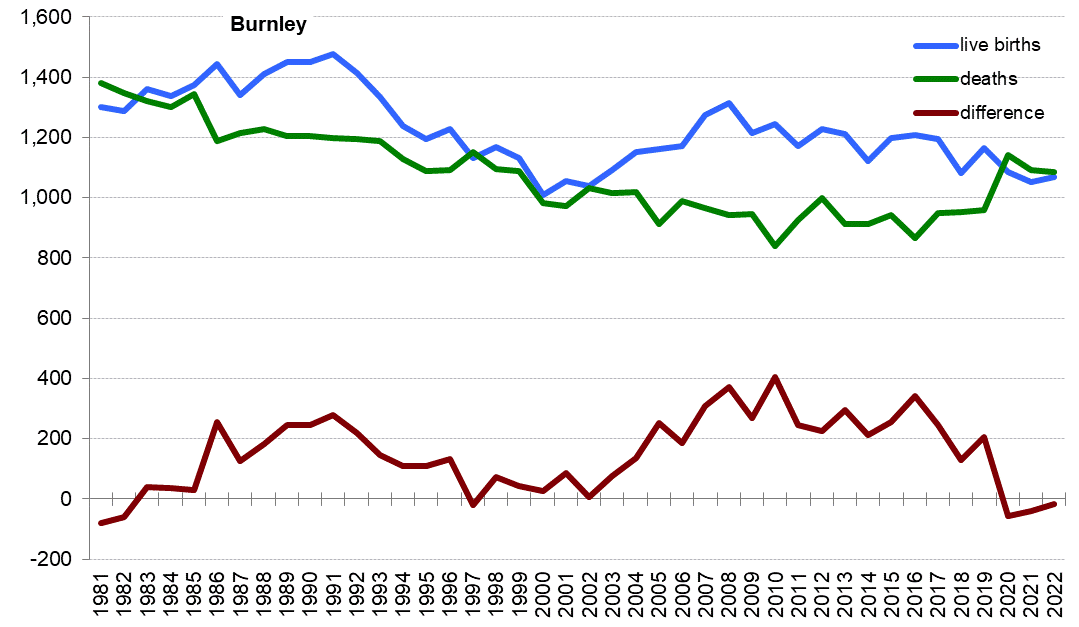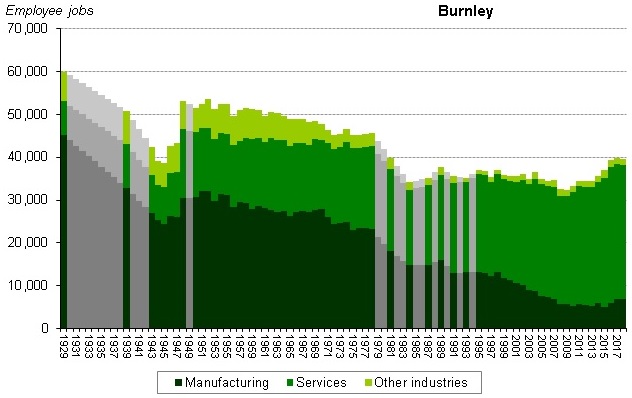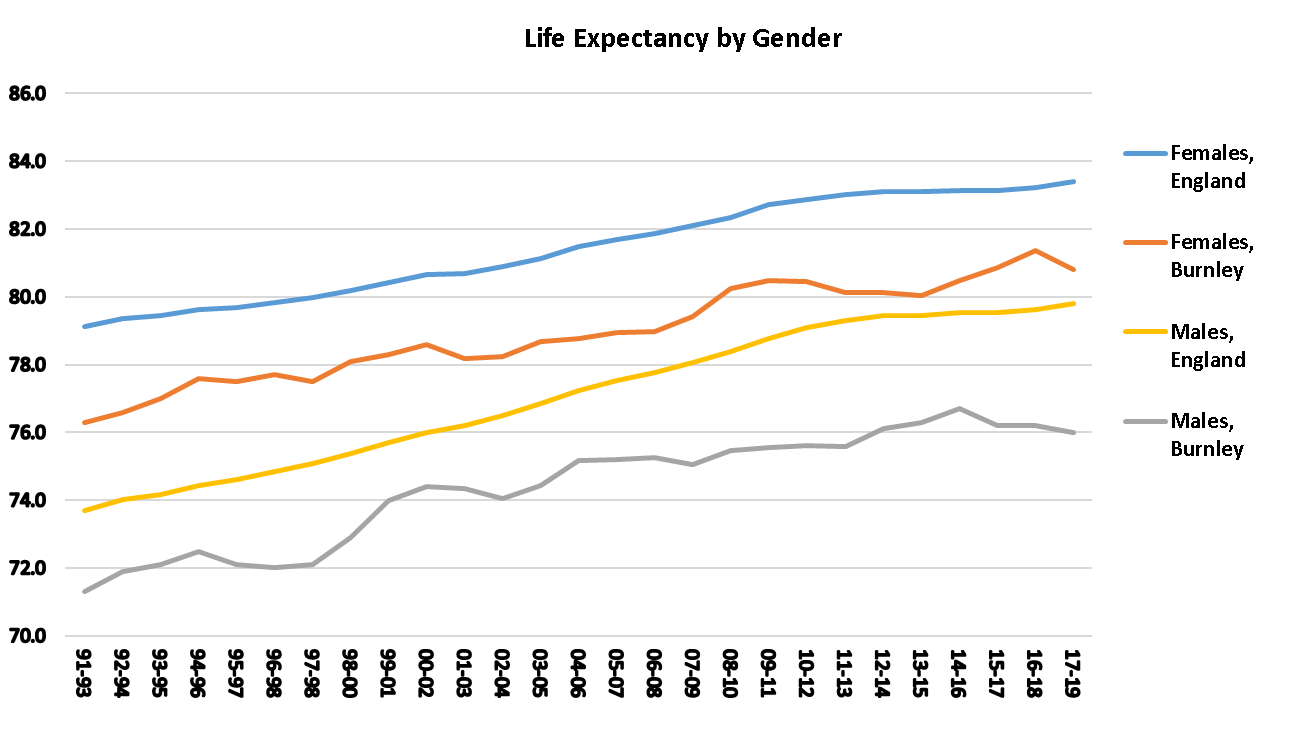Burnley district
This summary offers a snapshot of some of the most important economic, social and environmental factors in Burnley district with links through to the source information. The information has been allocated to one of seven themes:
- Children and Young People
- People and Communities
- Economic Development
- Community Safety
- Environment and Transport
- Health and Wellbeing
- Older People
Introduction
Burnley is an authority in East Lancashire that covers 111 square kilometres, has 15 wards of various shapes and sizes, and the number of people per km² is twice the England and Wales average. From an historic point of view there have been dramatic changes and the pace of future change is liable to increase
For young children and parents the county council's Children and Family Wellbeing Service has a search facility for local centres. The seven in the district are: Burnley Central Neighbourhood Centre, the Burnley Wood, Ightenhill, Reedley Hallows, South West Burnley and Whitegate Children and Family Wellbeing Services and the Chai Centre.
Only a relatively small number of families in Burnley have an income level that has led to them opting out of receiving child benefit.
Key stage 4 covers the two years of school education that incorporates GCSEs in maintained schools. A new secondary school GCSE accountability system was implemented in 2016, in which 'Attainment 8' measures achievement in maths and English plus other subjects with less weighting. The revised average in Burnley district for 2021/22 was 41.9. This was some way below the average for the Lancashire County Council area of 47.6, and was the lowest of the 12 districts in the county area. At Key Stage 1 level, the four sets of results for pupils achieving the expected standards in reading, writing, mathematics and science were in the lowest three in the Lancashire-14 area.
There are 48 schools in Burnley, of which 30 are primary and 5 secondary. A full list of schools in Lancashire is available. Ofsted inspection reports and the GOV.UK web page on schools performance are useful sources of local information.
The college campus has helped to underpin the redevelopment of the town centre. Burnley Campus is the result of an investment by UCLan that has brought University education to the town.
The county council's Young People's Service website has an activity and organisations search facility that lists a wide range of options for young people in each of the 12 districts within the county council area.
Business Intelligence and Public Health analysts at Lancashire County Council have produced Child health profiles for districts in Lancashire, including both district and ward elements for Burnley, and bringing together key indicators from Fingertips, the public health data collection from the Office for Health Improvement & Disparities (OHID).
The 2022 mid-year population estimate total for the authority was 95,553. In contrast to the county and the nation as a whole, the population in the authority was in long-term decline until 2013, since when it has recovered strongly. One of the first Census outputs made available is an interactive tool that compares the 2021 results with 2011 for local authorities. Using this we can see that the population aged under 15 increased by 14% between Censuses.
The total fertility rate can be used as an estimate of the fertility growth factor in the population. The rate in Burnley of 1.75 children per woman in 2022, was =4th highest in the Lancashire-14 area and above the England average (1.49). The authority has a tendency towards a younger population, particularly those aged under 15, and fewer people of pensionable age than is the average for England and Wales.
Local authority live births and deaths graphs are available that track changes in births and deaths since the 1980s for each authority in Lancashire. The graph for Burnley reveals that live births have normally exceeded the number of deaths over the long-term. Because of the Covid-19 pandemic most districts, including Burnley, had more deaths than births in 2020, 2021 and 2022. The number of deaths in each month of 2023 can be seen in the monthly mortality graph slide on the Lancashire Insight Covid-19 intelligence web page.

The ethnic mix (2021 census results) was similar to other authorities in East Lancashire. It is predominantly white. The largest minority ethnic group is Pakistani.
It is estimated that between 2018 and 2043 the population of Burnley will increase, but by less than the 7.2% rise expected for Lancashire-14, or the substantial 10.3% increase for England as a whole. The projected number of households in the authority is projected to increase by 9.9% between 2018 and 2043. This is well below the England figure of 16.2%.
Burnley has around 41,000 dwellings, 85% of which are owner occupied or private rented. As in other East Lancashire authorities, a very high proportion of its housing stock is in council tax band A. The authority also has a high percentage of vacant dwellings, although the number has declined significantly over recent years. The net additional dwellings figures for Burnley district had been either negative or quite low for some recent years. The net gain of 340 dwellings in 2017/18 was the highest this century, followed by 250 in 2018/19 and 230 in 2020/21.
Median house price to median earnings in the authority reveal a rate that is around half of the England average, and is the third lowest of the 309 authorities in England. When comparing the lowest quartile of prices paid with the lowest quartile of earnings, the ratio in Burnley is the lowest.
In Burnley, 15.9% of households in 2020 were classified as being in fuel poverty. This was the 50th highest rate out of 317 authorities in England. The main factors that determine this are the the energy efficiency status of the property, the cost of energy; and household income.
According to the 2019 index of multiple deprivation, Burnley was ranked as the 11th most deprived area out of 317 districts and unitary authorities in England. This was based on the rank of average rank. The results also show that 23 (38.3%) of the lower super output areas in the authority were ranked in the 10% most deprived in the country.
ONS has produced a set of residential-based area classifications using analysis of the 2011 Census. These are for very small statistical areas, but we have identified the most common groups for the electoral wards. Residents in five of Burnley's wards mostly fit into the 'Challenged Terraced Workers' group and in a further three wards into the 'Challenged Asian Terraces' group.
Over the past few years, Burnley recorded a welcome growth in employment at a time when Lancashire saw virtually no overall change.
Our extensive employment records allow us to monitor the changes to employee numbers from 1929 onwards. We have published separate graphs for each of the 14 Lancashire local authorities that reveal changes in total employee numbers and the shift from manufacturing to service sector employment. Methodological changes, and assumptions for missing years, reduce the accuracy of the graphs, but they do give a useful broad indication of changes over time.
The graph for Burnley is reproduced below and reveals that the employment level was at its highest in the authority in 1929.

In Burnley as in most places, the manufacturing sector has shed jobs over the years whilst the service sector has grown to become a far greater source of employment. However there still continues to be a bias towards a larger proportion of manufacturing employees in Burnley than is the norm.
The authority has a history of overall employment rates that are usually below the national average, although most recent figures appear more promising. The percentage of workless households is high in the authority.
In 2023 there were 2,670 active enterprises in Burnley. 2,325 of these had fewer than ten employees, a further 280 enterprises had under 50 employees and around 20 had more than 250.
The M65 has improved access to the area and a number of new business locations have been developed close to motorway junctions.
The website for Petty's Surveyors of Burnley contains details of a large number of available commercial sites in Burnley and across much of East Lancashire. Burnley has a rich heritage of former textile and other buildings and there are examples of quality office and other developments that generate new uses for these buildings. The Barnfield construction website highlights a number of industrial developments in Burnley district. These include the former Michelin Tyre factory site that is now occupied by Burnley’s largest employer Safran Nacelles along with other firms.
The 2011 census results reveal the strong commuter flows, over 4,600 in each direction, between Burnley and Pendle districts, while the average earnings in the authority during 2019 reveal a major difference of £40 between the workplace and resident based populations, indicating that Burnley benefits from outward commuter flows, some of which are outside the Lancashire border.
Assisted areas are those places where regional aid can be offered to undertakings, typically businesses, under European Union state aid rules. From 2014 to 2020 Burnley had 11 wards with assisted area status. Following the departure of the UK from the European Union, these rules no longer apply, but a Subsidy control bill is currently going through Parliament.
The most recent companies in Burnley district to win a Queen's Award for Enterprise are Colonial Gifts Ltd in 2012, Fort Vale Engineering Ltd in 2013, What More UK Limited in 2014 and Process Instruments UK Ltd in 2021.
The UK government properties database is a searchable list of all UK government property holdings and land assets. The web page for the North West region includes land and properties in Burnley district.
Of note is the Lancashire Digital Technology Centre that aims to improve the competitiveness of the North West's industries by stimulating technology innovation, research and development.
The survey of personal incomes by HM Revenue and customs broadly includes all individuals whose income is higher than the prevailing personal tax allowance and who are therefore liable to tax. The median results are the middle value that best reflects typical income and they show a low result for Burnley.
The authority contains a large number of employment and support allowance claimants. The housing benefit article reveals the number of recipients and the effect of the spare room subsidy withdrawal in the authority. In comparison to the national average, there is a high percentage of the working age population that is reliant on welfare benefits.
The town centre of Burnley is destined to benefit from a mix of funding sources which includes the Future High Streets Fund, channelled through the High Streets Heritage Action Zones scheme.
The recorded crime article reveals that Burnley has a noticeably higher crime rate than the Lancashire-14 area. See the LG Inform Quarterly Report on Crime and Disorder by Local Authority.
For more details on community safety in your neighbourhood, please enter your postcode or ward into the window in the Local area community safety statistics web page.
Alcohol is known to contribute to offending behaviour, particularly violence, anti-social behaviour and criminal damage. Residents in the authority have an above average number of hospital stays due to alcohol according to the LAPE (Local Alcohol Profiles for England).
There were 64 people killed or seriously injured in a road traffic collision in Burnley in 2022.
Transport has a key role to play in realising the economic potential of an area by unlocking key locations, such as the existing and new locations referred to in the economy section. Using sustainable transport modes can significantly improve employment opportunities and life chances. In urban areas the reliance on the car presents problems of traffic congestion and reduced air quality. The highly urbanised central core of Burnley has areas close to the motorway that have poor air quality results, especially for particulate emissions.
The East Lancashire Highways and Transport Masterplan is the strategic transport document for the wider area and contains references to transport issues in the authority.
The M65 provides direct links to the M6 and M61, whilst connections are also available via main 'A' roads in to Manchester and Yorkshire. The Department for Transport website has an interactive map that lists the traffic flows at hundreds of sites across all of the Lancashire County Council area.
Local rail services are provided by Northern Rail and encompass the Blackpool South/Preston to Colne service and Blackpool North to York route. There are five railway stations in the authority of which Burnley Manchester Road is by far the busiest and is the station for the semi-fast services between Blackpool North and York. From May 2015, a new service to Manchester Victoria calls at Rose Grove and Burnley Manchester Road.
In 2016/17, Burnley had an estimated rate of between 6.8% and 15.2% of residents who cycle at least once a month irrespective of length or purpose.
Maps are available that reveal the various rural-urban definitions across Lancashire down to the very small census output area level.
The National Biodiversity Network Gateway acts as a “data warehouse” for biodiversity information, which can be quickly and easily accessed to understand the distribution of particular species in the UK. Much of the local data is supplied by the Lancashire Environment Record Network (LERN), which is hosted by Lancashire County Council. An interactive map on this site shows the extent of the Environmental Record Centre coverage, including the LERN area, and when adding a species using the 'Add to Map' control, records of their sightings are displayed.
Green belts have been an enduring element of national planning policy. They check the unrestricted sprawl of large built-up areas; prevent neighbouring towns from merging into one another; assist in safeguarding the countryside, preserve the character of historic towns and encourage the recycling of derelict and other urban land. Burnley has a low proportion of its land designated as green belt and in the year to March 2019 this was reduced by a further 10 hectares.
Burnley has relatively low total carbon dioxide emissions. The rate of carbon dioxide tonnes per resident is low when compared with the county and national averages. Mortality attributed to poor air quality was better than the England average in 2019, but was the second worst in the Lancashire-14 area.
Lancashire County Council supports a various projects in district authorities via a range of grants and funding options.
The rates of household waste sent for reuse, recycling or composting have in general been improving over the years as sharp increases in Landfill Tax have made the traditional form of Landfill disposal much more expensive. In Burnley however, the household waste reuse, recycling and composting rate was in 2021/22 just 32.2%. This was the 3rd lowest rate out of the 14 Lancashire authorities. The same article also highlights the consistently high number of fly-tipping incidents recorded in the authority.
The legacy of former mine workings in the area was highlighted in 2015, when the coal authority published development risk plans and specific risk plans that included a set for Burnley district.
With a health index score of 85.3 in 2021 Burnley is in 15th lowest place among English local authorities
Figures for life expectancy at birth by local authority reveal that Burnley district has male and female averages significantly below the England figures. The following graph reveals life expectancy changes in the authority by three-year time periods from 1991-93 onwards. The graph emphasises the growing disparities between the Burnley and national averages, particularly for males.

The Burnley Health Profile, published by Public Health England, reveals that the health of people in Burnley is significantly worse than the England average, especially for infant mortality and physical activity rates.
The 2015 health behaviours summary report (PDF 451 KB) and lifestyle survey findings (PDF 957 KB) for Burnley provide further details on lifestyle behaviours such as smoking, drinking, substance use, physical activity, nutrition, excess weight and wellbeing.
In July 2022 Integrated Care Boards replaced the much smaller Clinical Commissioning Groups as clinically-led statutory NHS bodies responsible for the planning and commissioning of health care services for their local area, including the majority of the hospital and community NHS services. Together with their associated Integrated Care Partnerships, which includes representatives from the upper tier local authorities responsible for social care and public health, they form Integrated Care Systems (ICS). The single ICS covering the whole of the Lancashire-14 area is the Healthier Lancashire and South Cumbria ICS. That web page has a link to a glossary of the terms used and there is a further explanation on a Kings Fund web page.
The main local hospital in the authority is Burnley General one of the 5 managed by the East Lancashire Hospitals NHS Trust. There are also various health centres and clinics.
Routes healthcare is an independent specialist health care provider which can deliver that care in the client's own homes.
The local government association has produced 'housing, health and wellbeing profiles' for each local authority across the country. The figures go down to the ward level, and the Burnley profile has results from the census, the index of multiple deprivation and other data sources.
Public Health England has produced Cardiovascular disease profiles for each of the former clinical commissioning groups in England, in this case NHS East Lancashire CCG. There are separate reports for heart disease, stroke, diabetes and kidney disease.
The State Pension caseload number in the authority is just over 15,500. The article also has the Pension Credit figures which is a benefit for pensioners at the lower end of the income scale.
It has been well documented over recent years that people are living longer and that the older age-groups will record some dramatic increases over future years, with associated financial implications and demand for health and social care services. By 2043, the number aged 65 or over in Burnley is projected to reach 21,881.
Attendance allowance provides financial help to people aged 65 or over who are physically or mentally disabled. The caseload in November 2021 was around 2,210.
Life expectancy as mentioned earlier is increasing but there is no guarantee that the extra years of life will necessarily equate to extra years of healthy life expectancy. However, it is not a foregone conclusion that "extra" years of life expectancy should necessarily lead to additional years with ill health or disability. More suitable community services to enable independent living and more effective practice of preventive lifestyles and medicine has the potential to lengthen disability-free life expectancy, particularly in the case of the prevention and treatment of non-fatal but disabling diseases.
The Lancashire Care Homes Association is an organisation that represents care providers across the broader Lancashire area. The website lists a large number of care and nursing homes, along with domiciliary care agencies in the area. The details are listed to by major urban localities across the county.
There has been a growing tendency towards housing developments that are exclusively for people who are either retired or are approaching retirement. The presence of these sites can have an impact on concentrations of older people in particular areas. The site adjoining Gawthorpe Hall is an example of one of these developments in the authority.
Page updated 2 April 2024